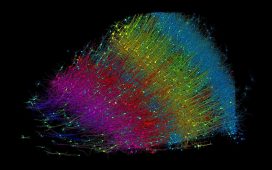I’ve been through my fair share of breakups. In fact, my most recent one was last month. I’ll spare you the details but it left me thinking: is there such a thing as “the one”? Or is each relationship just a mélange of random circumstances and individuals whose compatibility is based on which side of the river they grew up, whether or not they wear ankle socks, and sheer luck? I voice-noted all this to a friend while garnering more than my usual fair share of pitying looks in the Sainsbury’s checkout queue and was buoyed when she replied almost instantly: “No!!!! ur soulmate is coming, you just need to write your list and raise your vibration.”
She wasn’t referring to my ringtone or propensity to fidget. In the rhetoric of New Age spirituality, every person, object or emotion has its own unique “frequency” and in order to manifest something you must alter your own frequency to match the thing you want. Two years ago, this kind of jargon was limited to the eccentric colleague who, after undergoing a toad venom cleanse in Ibiza, decided to retrain as a yoga instructor, grow a rat-tail and extol the anti-ageing properties of snail slime. But since the pandemic, I would be hard pushed to find a friend who doesn’t check their vibrations, hasn’t Googled their partner’s astrological birth chart or used the term “my truth” or “manifested” at least once in the past month.
There has been a cultural shift in the way my 20- and 30-something peers and Gen Z social media users have begun talking about love, too. In the past, a breakup was “for the best”; now it is “predestined”. Pragmatism around relationships has given way to not settling for anything less than your “soulmate”, who has been “manifested” through months’ worth of careful visualisations or the “whisper method” – the internet’s answer to telepathy, which is all the rage on TikTok and YouTube. You’d be forgiven for thinking at this juncture that I have also consumed a kilo of toad venom, but this spiritual love language seems to have penetrated further than my corner of south-east London: according to a YouGov poll, 60% of Americans believe in soulmates, while the buzzword “twin flame” has been trending on Google since 2021 and the viral TikTok “soulmate moon phase test” has amassed millions of views since March.
What has prompted our interest in the mystical, spiritual and ephemeral when it comes to finding and understanding love? And is manifesting – the idea of turning your dreams and desires into reality – really the key to finding your soulmate? Corrina Taylor, a YouTuber and manifestation coach using the handle Corri T, stumbled across the manifestation community in 2020 when she was going through a breakup with her now-partner. In the throes of heartache she found an Alexandrian-sized library of content on YouTube, chat forums and Instagram promising to help you “manifest your ex back”. As instructed by the internet’s army of unlicensed spirituality coaches, Taylor set off on a gruelling regimen of daily mental exercises in order to attract her ex back into her life.
“I was always a spiritual person but discovered the art of manifestation during the pandemic,” she tells me. “It opened a can of worms. I thought, oh my God, I can manifest him, I can make him love me. I did visualisations, manifest scripting [writing your intentions and goals as if you have already achieved them] and wrote affirmations obsessively for almost a whole year. I realise, looking back, I was unhappy. I was literally outsourcing my sense of self-love, but the mad thing is that a lot of these visualisations actually came true. Fast forward a few years and my ex and me are living together and having a baby.”
Whether you believe in manifesting or not, Corrina’s YouTube tutorial detailing how she manifested her partner back has amassed 62,000 views since she posted it last year. As for manifesting itself, a recent UK study found that 60% of people surveyed believed in the power of willing their dreams into existence. And Kim Kardashian, that behemoth of the zeitgeist, was recently shown in The Kardashians writing a “manifestation list” of the qualities and features she wanted to attract in a prospective boyfriend.
Evolutionary anthropologist Dr Anna Machin explains that the failure of technology and particularly dating apps to create real connection is in part responsible for the shifting discourse around love. “Many are demoralised by the transactional nature of dating apps,” explains Machin. “They promised ease in relationships but in many cases they have made things harder and more complicated. They handicap our brain, which has not evolved to select a partner at a distance. We are supposed to be in the room [with people].”
A sense of disconnection, says Machin, can lead many of us to turn to spirituality in order to try to control our external environment. “When we cannot control something, and love is ultimately pretty uncontrollable, we tend to turn to myth and storytelling to help us explain the unknown and gain some control.”
A heightened desire for control, according to astrologer Susan Miller, has led millennials and Gen Zers to seek predictions for the arrival, appearance and exact coordinates of their soulmates. Miller, whose own clients are rumoured to include Cameron Diaz and Brad Pitt, explains that astrology can be used to check compatibility but it cannot predict love. “Younger people who graduated college after the financial crash and 11 years later experienced the pandemic think that the world is a terribly dangerous place,” she says. “Women in particular. It’s not as dangerous as they think it is, but when someone believes they are in an uncontrollable environment, they want more control, and that includes securing the perfect husband or the perfect partner.”
The experience of the pandemic may have shored up our feelings of uncertainty, but the notion of a mythic “one”, a specific person or perfect romantic match, has been percolating for millennia. In his book The Symposium, Plato hypothesised that all humans originally possessed two sets of arms and legs but after threatening the authority of the Olympian gods, Zeus punished the human race by throwing a lightning bolt down to Earth, ripping our bodies in two and dooming us to our present four-limbed state. Since then humans have been fated to spend the rest of their days yearning for their lost halves. In 1822 the Romantic poet Samuel Taylor Coleridge coined the term “soulmates” to describe that romantic “other half”, writing in a letter that “To be happy in Married Life… you must have a Soul-mate.” Unfortunately for Coleridge, his marriage disintegrated rapidly and the poet spent the last decade of his life living with his doctor.
Steph Skarbek, 30, a production manager from London, uses distinctly Platonian and transcendental language to frame her experiences of love. When she met her current partner, she says, she experienced a connection with him that bordered on “uncanny”. “Initially it was about the energy he had, which was very similar to my energy, almost on a frequency level. It is difficult to explain,’’ she says. “I’ve met someone who thinks in the same weird way that I do and it’s sort of like having another version of me. It’s uncanny.”
Jackie, 30, a photographer from London, believes her on-off partner is her “twin flame”, what New Age spirituality describes as a living being whose soul is the other half of yours, creating an instant, other-worldly chemistry. “I have a twin flame, the connection is kind of mad and the sex is incredible, and I’ve never felt more comfortable with someone. We have always revolved in a world of our own. We can never seem to get out of each other’s lives and keep running back to each other.”
Machin explains that the feeling of finding your soulmate can be ascribed to biobehavioural synchrony, a complicated subconscious process of mapping other people’s movements and facial expressions. “There are certainly people who are more compatible with you and a better fit than others, so every person certainly has a team of ‘the ones’ rather than just one person,” says Machin, debunking the idea that there is only one cosmic connection in each of our lifetimes.
Whether you whisper a prayer or write a manifestation list, the intention, it seems, is the same: a deep desire for connection and certainty. To my own script I would add: a full head of hair, rippling biceps, a foot on the property ladder… It’s a lot to visualise – but here’s hoping.











